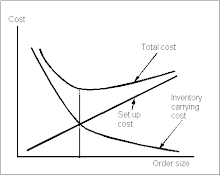Citi Bank announced this morning that they would be cutting approxiamately 50,000 jobs. This is just one example of a company cutting jobs as a result of the stagnating economy.
I believe that we can look at this situation and apply some of inventory management principles (however, this opinion might be far from the truth).
For instance, these companies are drastically reducing their levels of human capital, which means they will have to do more with less. They are basically trying to run a leaner organization, which could possibly be related to a company reducing the amount of inventory they carry by employing lean concepts.
On the other hand, there is also an increasing supply of unemployed workers in the marketplace. These unemployed individuals are probably willing to work for a smaller salary in light of these uncertain economic times. If we consider the workforce as a cost, then companies can now take advantage of acquiring their workforce at a reduced rate.
Does anyone have any thoughts or opinions on this subject???
-Andrew Freeman
Subscribe to:
Post Comments (Atom)

2 comments:
Good analysis, i agree. But it seems to me that it is more suitable to use the supply and demand model to analyze the workforce. Companies have fewer demand, and workers have more supply, leading to an equilibrium point with lower salary.
I am not sure if human capital can be treated as inventory, but I do think it makes for interesting discussion. Assuming human capital can be treated as inventory, then I have a concern with what Citi is doing.
Where did 50,000 come from? Since it is such a large number, I doubt it came from a model or some calcualtion which lets the company know how much human capital to have on hand. Otherwise, I would expect that we would have seen several significantly smaller cuts as the demand for human capital dimished. I imagine it is directly related to the percentage drop in revenues, or profits, or some other metric.
So, if I am right the reduction in jobs, is done in an effort to become lean ,as you stated, instead of as a byproduct of practicing lean principles. This type of decision making is the same type of decision making that causes the failure of lean implementation at many companies.
As we have discussed in class the inventory should be grouped into classes and then adjusted based on the inventory characteristics. Meaning the departments that are affected should most likely be affected differently. I am not sure of the specifics on the job cuts, but I doubt that this type of analyitical effort was used when the number of lay-offs was determined.
If I am right and the number of 50,000 jobs was an across the board effort to lower costs. Citi will be cutting arbitrarily, which is likely to cause problems with additional holding cost (overstaffed departments) and stockouts (understaffed departments).
It is possible that Citi was just so overstaffed that an across the board cut could be made to every department and then a more detailed look at the company could be made. However, I doubt that was the reasoning.
Jason
Post a Comment